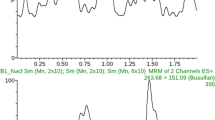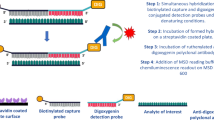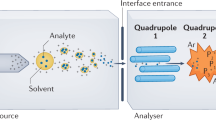Abstract
In the past few years, high-performance liquid chromatography tandem mass spectrometry (HPLC-MS/MS) has matured to a true alternative to antibody-based immunoassays in routine therapeutic drug monitoring. In transplantation medicine, mass spectrometry-based assessment of immunosuppressant drug levels is considered a gold standard diagnostic procedure. We describe a fast state-of-the-art routine online solid-phase extraction (SPE) HPLC-MS/MS analysis platform that allows monitoring of cyclosporine A, tacrolimus, sirolimus and everolimus from 50-μl aliquots of EDTA whole blood specimens within 3.4 min total analysis time. Sample purification is done by offline protein precipitation followed by two automated chromatographic separation steps. Mass spectrometry-based analyte quantification relies on selected reaction monitoring experiments. The assay underwent complete validation and performance evaluation studies and performs very well in several international proficiency testing schemes. In daily routine, it allows reporting of about 75 patient sample results per work shift with a typical total individual sample turnaround time of less than 3 h.
This is a preview of subscription content, access via your institution
Access options
Subscribe to this journal
Receive 12 print issues and online access
$259.00 per year
only $21.58 per issue
Buy this article
- Purchase on Springer Link
- Instant access to full article PDF
Prices may be subject to local taxes which are calculated during checkout




Similar content being viewed by others
References
Geoghegan, K.F. & Kelly, M.A. Biochemical applications of mass spectrometry in pharmaceutical drug discovery. Mass Spectrom. Rev. 24, 347–366 (2005).
Korfmacher, W.A. Foundation review: principles and applications of LC-MS in new drug discovery. Drug Discov. Today 10, 1357–1367 (2005).
Hopfgartner, G. Mass spectrometry in bioanalysis—methods, principles and instrumentation. In Methods and Principles in Medicinal Chemistry Vol. 36 (eds. Wanner, K. & Höfner, G.) 3–62 (Wiley-VCH, Weinheim, Germany, 2007).
de Boer, A.R., Lingeman, H., Niessen, W.M.A. & Irth, H. Mass spectrometry-based biochemical assays for enzyme-inhibitor screening. TRAC-Trend Anal. Chem. 26, 867–883 (2007).
Vogeser, M. & Seger, C. A decade of HPLC-MS/MS in the routine clinical laboratory—goals for further developments. Clin. Biochem. 41, 649–662 (2008).
Seger, C. & Griesmacher, A. Some important aspects of implementing tandem mass spectrometry in a routine clinical laboratory environment. Biochemia Medica 17, 29–51 (2007).
Chace, D.H. Mass spectrometry in the clinical laboratory. Chem. Rev. 101, 445–477 (2001).
Taylor, P.J. High-performance liquid chromatography-mass spectrometry in the clinical laboratory. Ther. Drug Monit. 27, 689–693 (2005).
Yang, Z., Peng, Y. & Wang, S. Immunosuppressants: pharmacokinetics, methods of monitoring and role of high performance liquid chromatography/mass spectrometry. Clin. Appl. Immunol. Rev. 5, 405–430 (2005).
Saint-Marcoux, F., Sauvage, F.-L. & Marquet, P. Current role of LC-MS in therapeutic drug monitoring. Anal. Bioanal. Chem. 388, 1327–1349 (2007).
Oellerich, M. & Armstrong, V.W. The role of therapeutic drug monitoring in individualizing immunosuppressive drug therapy: recent developments. Ther. Drug Monit. 28, 720–725 (2006).
Morris, R.G. Immunosuppressant drug monitoring: is the laboratory meeting clinical expectations? Ann. Pharmacother. 39, 119–127 (2005).
Ghoshal, A.K. & Soldin, S.J. IMx tacrolimus II assay: is it reliable at low blood concentrations? A comparison with tandem MS/MS. Clin. Chem. 35, 389–392 (2002).
Johnston, A. et al. Monitoring cyclosporin in blood: between-assay differences at trough and 2 h post-dose (C2). Ther. Drug Monit. 25, 167–173 (2003).
Steimer, W. Performance and specificity of monoclonal immunoassays for cyclosporine monitoring: how specific is specific? Clin. Chem. 45, 371–381 (1999).
Seger, C., Stöggl, W., Tentschert, K., Ramsay, S. & Griesmacher, A. Flexibility in the chromatography setup of a HPLC-MS/MS based immunosuppressant TDM platform allows to add MPA monitoring without hardware changes. Ther. Drug Monit. 29, 510 (2007).
Hochegger, K. et al. Differential effects of rapamycin in anti-GBM glomerulonephritis. J. Am. Soc. Nephrol. 19, 1520–1529 (2008).
Seger, C., Tentschert, K., Hammerer-Lercher, A. & Griesmacher, A. Implementing an immunosuppressant TDM HPLC-MS/MS platform in a clinical environment: comparison with commercial immunoassays as key step in the performance evaluation. Ther. Drug Monit. 29, 505 (2007).
Annesley, T.M. & Clayton, L. Simple extraction protocol for analysis of immunosuppressant drugs in whole blood. Clin. Chem. 50, 1845–1848 (2004).
Streit, F., Armstrong, V.W. & Oellerich, M. Rapid liquid chromatography-tandem mass spectrometry routine method for simultaneous determination of sirolimus, everolimus, tacrolimus, and cyclosporin A in whole blood. Clin. Chem. 48, 955–958 (2002).
Ceglarek, U. et al. Rapid simultaneous quantification of immunosuppressants in transplant patients by turbulent flow chromatography combined with tandem mass spectrometry. Clin. Chim. Acta. 346, 181–190 (2004).
Koal, T., Deters, M., Casetta, B. & Kaever, V. Simultaneous determination of four immunosuppressants by means of high speed and robust on-line solid phase extraction-high performance liquid chromatography-tandem mass spectrometry. J. Chromatogr. B 805, 215–222 (2004).
Korecka, M., Solari, S.G. & Shaw, L.M. Sensitive, high throughput HPLC-MS/MS method with on-line sample clean-up for everolimus measurement. Ther. Drug Monit. 28, 484–490 (2006).
Deters, M., Kirchner, G., Resch, K. & Kaever, V. Simultaneous quantification of sirolimus, everolimus, tacrolimus and cyclosporine by liquid chromatography-mass spectrometry (LC-MS). Clin. Chem. Lab. Med. 40, 285–292 (2002).
Christians, U. et al. Automated, fast and sensitive quantification of drugs in blood by liquid chromatography-mass spectrometry with on-line extraction: immunosuppressants. J. Chromatogr. B 748, 41–53 (2000).
Volosov, A., Napoli, K.L. & Soldin, S.J. Simultaneous simple and fast quantification of three major immunosuppressants by liquid chromatography-tandem mass spectrometry. Clin. Biochem. 34, 285–290 (2001).
Vogeser, M., Zachoval, R., Spöhrer, U. & Jacob, K. Potential lack of specificity using electrospray tandem-mass spectrometry for the analysis of mycophenolic acid in serum. Ther. Drug Monit. 23, 722–724 (2001).
Yang, Z. & Wang, S. Recent development in application of high performance liquid chromatography-tandem mass spectrometry in therapeutic drug monitoring of immunosuppressants. J. Immunol. Methods 336, 98–103 (2008).
Wang, S., Magill, J.E. & Vicente, F.B. A fast and simple high-performance liquid chromatography/mass spectrometry method for simultaneous measurement of whole blood tacrolimus and sirolimus. Arch. Pathol. Lab. Med. 129, 661–665 (2005).
Salm, P. et al. Evaluation of a fluorescent polarization immunoassay for whole blood everolimus determination using samples from renal transplant recipients. Clin. Biochem. 39, 732–738 (2006).
Napoli, K.L. Is microparticle enzyme-linked immunoassay (MEIA) reliable for use in tacrolimus TDM? Comparison of MEIA to liquid chromatography with mass spectrometric detection using longitudinal trough samples from transplant recipients. Ther. Drug Monit. 28, 491–504 (2006).
Keevil, B.G., McCann, S.J., Cooper, D.P. & Morris, M.R. Evaluation of a rapid micro-scale assay for tacrolimus by liquid chromatography-tandem mass spectrometry. Ann. Clin. Biochem. 39, 487–492 (2002).
Napoli, K.L. Organic solvents compromise performance of internal standard in proficiency testing of mass spectrometry-based assays for tacrolimus. Clin. Chem. 52, 765–766 (2006).
Annesley, T.M. Methanol-associated matrix effects in electrospray ionization tandem mass spectrometry. Clin. Chem. 53, 1827–1834 (2007).
Ekberg, H. et al. Reduced exposure to calcineurin inhibitors in renal transplantation. N. Engl. J. Med. 357, 2562–2575 (2007).
Vogeser, M. & Spoehrer, U. Pitfall in the high-throughput quantification of whole blood cyclosporin A using liquid chromatography-tandem mass spectrometry. Clin. Chem. Lab. Med. 43, 400–402 (2005).
Seger, C., Bock, M., Tentschert, K. & Griesmacher, A. Evaluating co–medication and matrix interference influence on ion yields: a key step in TDM HPLC-MS/MS assay validation. Ann. Transplant. 13 (Supp 1): 38 (2008).
Bland, J.M. & Altman, D.G. Statistical methods for assessing agreement between two methods of clinical measurement. Lancet 327, 307–310 (1986).
Stoeckl, D., Cabaleiro, D.R., Van Uytfanghe, K. & Thienpont, L.M. Interpreting method comparison studies by use of the Bland-Altman plot: Reflecting the importance of sample size by incorporating confidence limits and predefined error limits in the graphic. Clin. Chem. 50, 2216–2218 (2004).
Pfisterer, H., Seger, C., Griesmacher, A. & Schmid, R. Comparison of different HPLC-MS/MS based assays for sirolimus TDM—data from an inter-laboratory study. Ther. Drug Monit. 29, 507 (2007).
Author information
Authors and Affiliations
Corresponding author
Rights and permissions
About this article
Cite this article
Seger, C., Tentschert, K., Stöggl, W. et al. A rapid HPLC-MS/MS method for the simultaneous quantification of cyclosporine A, tacrolimus, sirolimus and everolimus in human blood samples. Nat Protoc 4, 526–534 (2009). https://doi.org/10.1038/nprot.2009.25
Published:
Issue Date:
DOI: https://doi.org/10.1038/nprot.2009.25
This article is cited by
-
Reduction of 2,6-dimethoxyphenol odor emitted from Ribbed Smoked Sheet by Co(II)-salen complex
Air Quality, Atmosphere & Health (2024)
-
Evaluation of a coated blade spray-tandem mass spectrometry assay as a new tool for the determination of immunosuppressive drugs in whole blood
Analytical and Bioanalytical Chemistry (2020)
-
Plasma clot formation and clot lysis to compare effects of different anticoagulation treatments on hemostasis in patients with atrial fibrillation
Clinical and Experimental Medicine (2018)
-
Anti-coagulation assessment with prothrombin time and anti-Xa assays in real-world patients on treatment with rivaroxaban
Annals of Hematology (2015)
-
Simultaneous Measurement of Cyclosporine A, Everolimus, Sirolimus and Tacrolimus Concentrations in Human Blood by UPLC–MS/MS
Chromatographia (2015)
Comments
By submitting a comment you agree to abide by our Terms and Community Guidelines. If you find something abusive or that does not comply with our terms or guidelines please flag it as inappropriate.



